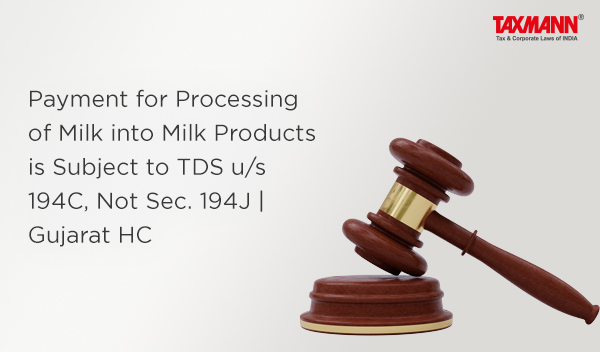Payment for Processing of Milk into Milk Products is Subject to TDS u/s 194C, Not Sec. 194J | Gujarat HC
- Blog|News|Income Tax|
- 2 Min Read
- By Taxmann
- |
- Last Updated on 28 November, 2023
Case Details: PCIT vs. Maahi Milk Producer Co. Ltd. - [2023] 156 taxmann.com 217 (Gujarat)
Judiciary and Counsel Details
-
- Biren Vaishnav & Bhargav D. Karia , JJ.
- Karan Sanghani, Ld. Sr. Standing Counsel & Mrs Kalpana K Raval for the Appellant.
Facts of the Case
The assessee was engaged in the business of selling milk and milk products. It made payments to a dairy for converting raw milk into processed milk and milk products and deducted tax at source under section 194C at 2%, treating payments as contract payments.
Assessing Officer (AO) held that the payments were in the nature of payments for technical services. Thus, the same should have been subjected to TDS at the rate of 10% under section 194J. Under section 40(a)(ia), he made disallowance on the proportionate amount of payments for short tax deduction at source at the rate of 8 percent.
On appeal, the Tribunal deleted the additions, and the matter reached the Gujarat High Court.
High Court Held
The High Court held that the assessee provided raw milk and necessary materials to the dairies for processing as per specification. The dairies pack it on a job-work basis. Since the job work falls within the definition of ‘work’ under section 194C, the assessee deducted tax under section 194C on conversion charges paid to such dairies.
The services rendered by the dairies were not technical services. The dairies were not experts on any technology they could provide to the assessee, nor did they provide any managerial or consultancy services. The dairies were not assigned any exclusive work relating to quality checks but were assigned work relating to the conversion or processing of milk and milk products, wherein one of the requirements is to ensure quality parameters. The main and basic nature of the transaction viz., conversion or processing of milk on a job-work basis does not lose its true characteristic.
Accordingly, the appeal was dismissed.
List of Cases Referred to
-
- Dy. CIT v. Maahi Milk Producer Co. Ltd. [IT Appeal No. 161 (Rjt.) of 2017, dated 23-3-2018] (para 5).
Disclaimer: The content/information published on the website is only for general information of the user and shall not be construed as legal advice. While the Taxmann has exercised reasonable efforts to ensure the veracity of information/content published, Taxmann shall be under no liability in any manner whatsoever for incorrect information, if any.

Taxmann Publications has a dedicated in-house Research & Editorial Team. This team consists of a team of Chartered Accountants, Company Secretaries, and Lawyers. This team works under the guidance and supervision of editor-in-chief Mr Rakesh Bhargava.
The Research and Editorial Team is responsible for developing reliable and accurate content for the readers. The team follows the six-sigma approach to achieve the benchmark of zero error in its publications and research platforms. The team ensures that the following publication guidelines are thoroughly followed while developing the content:
- The statutory material is obtained only from the authorized and reliable sources
- All the latest developments in the judicial and legislative fields are covered
- Prepare the analytical write-ups on current, controversial, and important issues to help the readers to understand the concept and its implications
- Every content published by Taxmann is complete, accurate and lucid
- All evidence-based statements are supported with proper reference to Section, Circular No., Notification No. or citations
- The golden rules of grammar, style and consistency are thoroughly followed
- Font and size that’s easy to read and remain consistent across all imprint and digital publications are applied








 CA | CS | CMA
CA | CS | CMA


